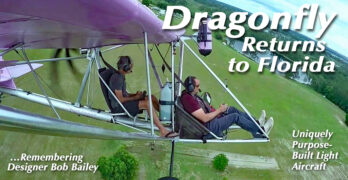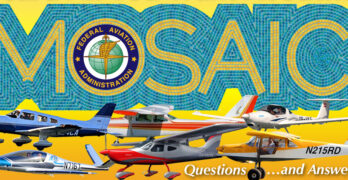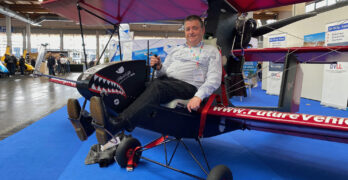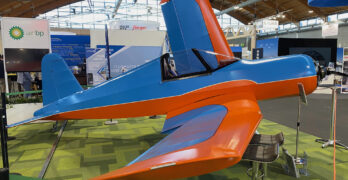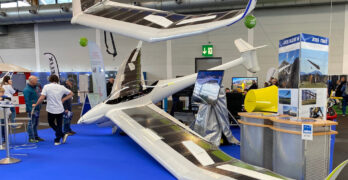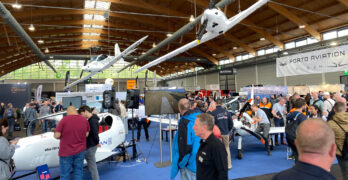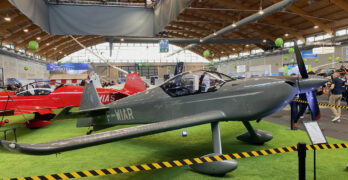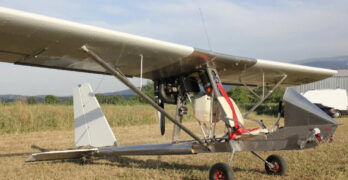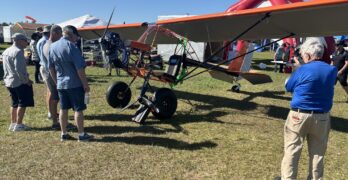With the MOSAIC program now through the comment phase and in the hands of the FAA, we thought it would be a good time to recap some of its key elements and use our considerable powers of observation and prognostication to provide a little context where needed. Join me, Dan Johnson and LAMA president Scott Severen for a wide-ranging talk on MOSAIC.
Dragonfly Is Back Home in Florida — Hang Glider Tug … Working Ranch “Tractor”
Dragonfly was born in Florida in the early 1990s. Back-of-the-napkin sketches started in the 1980s following the dynamic 1970s when hang gliding swooped into national awareness. What one designer did with Dragonfly would become one of the most celebrated developments in hang gliding.
Throughout the ’70s, hang glider designs accelerated smartly in glide performance and sink rate, stretching from slope-hugging 4:1 triangular-shaped wings to elegantly long and slender “bladewings” that could exceed a 20:1 glide yet remain foot-launchable and still be an aircraft you could carry on your shoulder (when folded down). Passionate enthusiasts thrilled to a 5X performance improvement in a decade or so.
In the beginning, most pilots launched off mountains to get enough height to catch thermals. Yet lots of America doesn’t have mountainous terrain. Florida had plenty of pilots eager to fly hang gliders but to find the best soaring, they had to load up their gliders and drive 10-12 hours to the hills of Tennessee where flight park operators like me catered to them with mountain launch sites.
MOSAIC Update & A Call For Questions
There’s little question we’ve covered MOSAIC extensively here on ByDanJohnson.com and have been looking ahead to a day when the proposal is a rule, sport pilots gain access to a whole raft of new aircraft, legacy LSAs have a chance to expand their operating envelopes and many of the companies planning to make new models that fit into the MOSAIC template actually come to market. Yeah, that’s a lot. And, yes, we’re all a little impatient for the FAA to make MOSAIC real.
Since the comment period closed in January, there’s been plenty of industry talk and one major airshow where MOSAIC was definitely a topic of conversation. With that in mind, Dan Johnson, Scott Severen (LAMA’s president) and I are meeting next week (virtually) to catch each other up on the program—video of this meeting will post here next week.
As we prepare for it, I’d like to invite you to submit questions you have and we’ll take them up during our chat.
AERO Wrapup: Dave Unwin Concludes His Coverage of AERO Friedrichshafen 2024
With my feet failing fast, and the lederhosen beginning to chafe in a most disagreeable fashion, I viewed the end of AERO 2024 with mixed emotions. My legs said enough is enough, but my head, heart and eyes still wanted more—because what a show it was! From replica rocket-powered fighters to jet packs, LSAs fitted with turbines and paramotors for paraplegics and finally to biplane pusher SSDRs, it was a fabulous event.
The AERO team produced a show that they could justifiably be proud of for the 30th anniversary, and although the weather was unseasonably cool, the action in the halls was as hot as ever, and with more than 270 aircraft in the exhibition halls and in the static display, show-goers were not short of mouth-watering machines to tempt their wallets.
Among the aircraft debuting at the show were the electric DA40 aircraft from Diamond Aircraft in Austria, two electric aircraft and a hydrogen powered one from China and the Integral E from French manufacturer Aura Aero.
Day 4 at AERO: A Few More Conventional Aircraft But Also a Few Surprises!
I’ll take the opportunity in this installment to take a look at some of the lighter aircraft to be seen at AERO Friedrichshafen this year.
ICP Ventura 2 and Ventura 4
Italian airframer ICP had several aircraft on display including the Ventura 2 ultralight powered by various permutations of Rotax, and also the Experimental, which as well as being fitted with a Rotax can also be powered by a Lycoming of up to 180 hp. The Venture 2 is a side-by-side two-seater, while the Ventura 4 is, as the name suggests, a four-seater specifically designed to meet the requirements of amateur construction and suitable for the Experimental category. ICP claims that a first time builder can reasonably expect to finish the aircraft in between 700 to 800 hours, while a more experienced builder with practical build experience can complete the aircraft in around 400 hours, excluding paint and upholstery. ICP also had the Savannah SR on show, and this machine bore quite a strong resemblance to the Zenith 701.
Day 3 at AERO: A Look At Sailplanes & Towplanes
The cavernous halls of the Messe truly do contain the aspirations and, let’s be honest, the dreams of literally dozens of designers. There were quite possibly more new types than I have ever seen, and I’ve been attending the Friedrichshafen show for over 20 years. Anyone who claims general aviation is dying would only need to see this show to have their viewpoint radically altered.
Gliding has always been well represented at AERO, and in the show’s 30th year all the major sailplane manufacturers were out in force. For many years AERO was a biennial event and when the organizers made it an annual show, many decided to stick with the biennial schedule and only attend on even-numbered years. There were many different permutations of self-launching and self-sustaining sailplanes on show, which utilized piston engines, electric motors and small jets.
Jonker JS3
South African company Jonker has several versions of the “engine-on-stick” solution for its JS3 single seat high performance sailplane, including an electric motor turning a two-blade propeller and a small jet.
Day 2 at AERO: The Show Gets Busier and So Does Our Correspondent!
Day Two of AERO at Friedrichshafen, and after a slow start footfall-wise yesterday there were considerably more visitors thronging the massive Messe today.
Aura Aircraft
The day started with a visit to the Aura Aircraft press conference, where the French airframer announced that it was signing a deal with the Deutsch aeroclub to use its Integra E electric two-seater as a glider tow plane. As a very experienced tug pilot and having been Tug Master at two different gliding clubs. I found this initiative both extremely interesting and very exciting. Noise and pollution are two very hot topics in Germany—and indeed most of Europe, and while all the gliding clubs are keen to promote the sport as being both green and sustainable, critics will always point to the noisy, gas guzzling Piper Pawnees and Robin DR400s and observe that it isn’t as green as they claim.
This initiative is certainly very laudable and could have significant implications for the gliding community.
Day 1 at AERO: Affordable Aviation at Friedrichshafen
Editor’s Note: Correspondent Dave Unwin is at the AERO show in Friedrichshafen, Germany, this week and will be reporting on news from the show. Here’s his first report.
Europe’s top general aviation event, AERO at Friedrichshafen, Germany opened on Wednesday, April 17, and runs through Sunday. It is no exaggeration to say that AERO has grown to become one of the biggest and best GA events on the planet—and certainly the biggest outside of North America.
This year is the 30th time the event has been staged and the organizers claim that more than 680 exhibitors from 36 countries are attending, which may well make the 2024 AERO the biggest ever.
The amount and diversity of aircraft on display was truly breathtaking, from a full-scale Me163 replica, powered by a small jet engine typically fitted to self-sustaining sailplanes, to the very latest bizjets. Unsurprisingly, there were several electric aircraft on display, and Bristell—in partnership with H55—had flown its final prototype of the electric Bristell B23 Energic to the show.
Break It Down — See the TrueLite’s Wing Fold In Real Time
At Sun ‘n Fun 2024, Aeromarine’s Chip Erwin demonstrated just how quickly the TrueLite’s wing can be folded. Of course, he’s pretty practiced at it and there’s still one more to do, but it’s impressive nonetheless.
Top Rudder — Have It Your Way
Top Rudder Aircraft, maker of the new Solo (Part 103) and Ruckus (LSA) aircraft, has one of the hottest booths at this year’s Sun ‘n Fun.
The company sold six of 10 available slots it had for planes in 2024 before the show opened on Friday. Both planes are based on a Troy Woodard design that had been around for a while, but it was only three months ago that Bryce Angel started Top Rudder to make these ultralight and light sport variants.
“It’s designed like a 1300-pound aircraft that’s we’ve modified for two entirely different kinds of flying,” explains Top Rudder’s Chief Engineer George Boney. “It can handle up to 200 hp, but our standard Polini 303 allows for stall speeds under 20 mph and a cruise of 50 for ultralight flying. Or, you can add another fuel tank, a slightly larger engine and tires and have an inexpensive backcountry sport plane that has real STOL capabilities.”
In its sport configuration with the Polini, the plane weighs about 350 pounds and is capable of limited acrobatics.
- « Previous Page
- 1
- …
- 3
- 4
- 5
- 6
- 7
- …
- 22
- Next Page »



